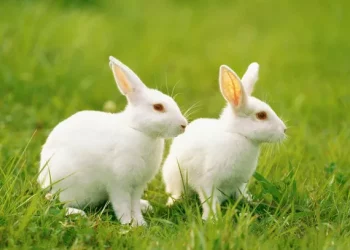Introduction to Cottontail Rabbits
Cottontail rabbits are among the most recognizable and widespread species of rabbits in North America. Named for their distinctive fluffy white tails, cottontails are a common sight in various habitats, ranging from fields and forests to suburban neighborhoods. Their habitats typically include dense vegetation for cover, as well as access to open areas for foraging and grazing.
Encounters with wild cottontail rabbits are not uncommon, especially in areas where human development encroaches upon their natural habitats. Whether spotted darting across a backyard lawn or nibbling on vegetation at the edge of a forest, these small mammals often capture the attention and curiosity of onlookers.
Dietary Habits of Cottontail Rabbits
Cottontail rabbits are primarily herbivores, meaning their diet consists mainly of plant matter. In the wild, they forage for a variety of foods, including grasses, leaves, twigs, buds, fruits, and vegetables. This diverse diet provides them with essential nutrients, fiber, and hydration necessary for their survival and overall health.
Their feeding habits vary depending on the season and availability of food sources. During warmer months, cottontails may focus on fresh green vegetation, while in the winter, they may resort to consuming bark, twigs, and dried grasses when fresh greens are scarce.
The Importance of a Natural Diet
Mimicking a wild rabbit‘s natural diet is crucial for their health and well-being. Deviating from their natural dietary habits can lead to nutritional deficiencies, digestive problems, and other health issues. Unlike domestic rabbits, which may have adapted to commercial pellet diets, wild cottontails rely on a diverse array of vegetation to meet their nutritional needs.
A natural diet not only sustains their physical health but also promotes natural behaviors and instincts essential for their survival in the wild. By providing foods that mimic what they would find in their natural environment, we can help support their overall health and contribute to their ability to thrive in the wild.
Safe Foods to Feed Wild Cottontail Rabbits
If you encounter a wild cottontail rabbit and wish to offer supplemental food, it’s essential to provide safe and appropriate options. Some suitable foods for wild cottontails include:
Leafy Greens: Dandelion greens, kale, spinach, and lettuce (in moderation).
Vegetables: Carrots, broccoli, celery, and bell peppers (cut into small pieces).
Fruits: Apples, strawberries, blueberries, and bananas (in small quantities).
Herbs: Parsley, cilantro, and basil can be offered sparingly.
Hay: High-quality grass hay can provide fiber and help mimic their natural foraging behavior.
When offering fruits and vegetables, it’s essential to wash them thoroughly and remove any pesticides or harmful residues that could be present. Additionally, foods should be offered in small quantities to prevent overfeeding and digestive upset.
Foods to Avoid
While certain foods are safe for wild cottontail rabbits, others can be harmful or even toxic to them. Foods to avoid feeding wild rabbits include:
Processed Foods: Avoid offering processed snacks, bread, or sugary treats, as they lack nutritional value and can disrupt their digestive system.
Human Food: Foods high in fat, sugar, or salt, such as chips, cookies, and fast food leftovers, should never be given to wild rabbits.
Toxic Plants: Plants like rhubarb, nightshade, and lily of the valley are toxic to rabbits and should be kept out of their reach.
Grains and Seeds: While grains and seeds may seem like natural rabbit foods, they can cause digestive issues and should be avoided.
It’s crucial to research any unfamiliar foods before offering them to wild rabbits to ensure they are safe and suitable for consumption.
Feeding Practices
When providing supplemental food to wild cottontail rabbits, it’s essential to follow best practices to promote their health and well-being:
Frequency: Offer food in small amounts once or twice daily to supplement their natural diet without encouraging dependency.
Quantity: Avoid overfeeding by providing only small portions of food to prevent obesity and digestive problems.
Timing: The best time to offer food is during dawn or dusk when rabbits are most active. Avoid feeding at night to minimize the risk of attracting predators.
Placement: Scatter food in natural areas or near dense vegetation where rabbits feel safe and can easily access it. Avoid feeding in open areas where rabbits may feel exposed to predators.
Water: Provide a shallow dish of fresh water for hydration, especially during dry or hot weather.
By adhering to these feeding practices, we can help supplement the natural diet of wild cottontail rabbits while minimizing the risks associated with human interaction.
Human Interaction with Wild Rabbits
While providing supplemental food to wild cottontail rabbits can be well-intentioned, it’s essential to consider the potential implications of human interaction with wild animals. Feeding wild rabbits can lead to several unintended consequences, including:
Dependency: Regular feeding can cause wild rabbits to become dependent on human-provided food, disrupting their natural foraging behaviors and potentially impacting their ability to survive without assistance.
Health Risks: Improper or excessive feeding can lead to nutritional imbalances, obesity, digestive problems, and an increased risk of disease transmission among rabbit populations.
Predator Attraction: Food sources intended for rabbits may also attract predators, putting both rabbits and other wildlife at risk.
While observing and appreciating wildlife can be a rewarding experience, it’s essential to do so from a respectful distance and avoid interfering with their natural behaviors and habitat.
Conclusion
Feeding wild cottontail rabbits requires careful consideration of their dietary needs, safety, and the potential consequences of human interaction. By providing safe and appropriate foods that mimic their natural diet, we can support their health and well-being without encouraging dependency or disrupting their natural behaviors.
It’s crucial to remember that wild animals, including cottontail rabbits, are best left to fend for themselves in their natural habitats. While small acts of kindness, such as offering supplemental food, may seem harmless, they can have significant impacts on the long-term health and survival of wild populations.
As stewards of the environment, we have a responsibility to respect and protect wildlife, ensuring they can thrive in their natural habitats for generations to come. Let us appreciate the beauty of wild cottontail rabbits from a distance, allowing them to live freely and undisturbed in their natural environment.
Related Topics:























